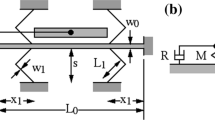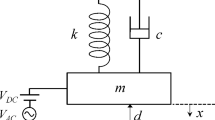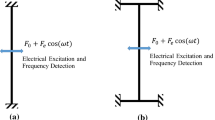Abstract
Array forms of MEMS resonator that uses a specific mid-frequency normal mode have been introduced for acquiring a wider bandwidth of frequency response function (FRF). A conventional frequency response solver based on a modal approach faces computational difficulties in obtaining the FRF of these array forms because of the increase in the order of a linear dynamic model and the number of retained normal modes. The computational difficulties can be resolved by using a substructuring-based model order reduction and a frequency sweep algorithm, which requires a smaller number of retained modes of a reduced dynamic system than the conventional solver. In computing the FRF of a single resonator and its array forms, the presented method shows much better efficiency than the conventional solution by ANSYS as the number of resonators increases. In addition, the effects of multiple resonators in the array forms on filter performance are discussed compared with experimental data.
Similar content being viewed by others
References
Y. Xie, S. S. Li, Y. W. Lin, Z. Ren and C. T. C. Nguyen, UHF micromechanical extensional wing-glass mode ring resonators, Technical digest, 2003 IEEE International electron devices meeting, Washington DC (2003).
D. Weinstein, S. A. Bhave, M. Tada, S. Mitarai and S Morita, Mechanical Coupling of 2D Resonator Arrays for MEMS Filter Applications, IEEE International Frequency Control Symposium (FCS 2007), Geneva, Switzerland, (2007).
J. K. Bennighof and M. F. Kaplan, Frequency sweep analysis using multi-level substructuring, global modes and iteration. Proceedings of 39th AIAA/ASME/ASCE/AHS Structures, Structural Dynamics and Materials Conference, (1998).
D. Choi, H. Kim and M. Cho, Improvement of Substructuring Reduction Technique for Large Eigenproblems Using an Efficient Dynamic Condensation Method, Journal of Mechanical Science and Technology 22(2) (2008), 255–268.
C.-W. Kim and J. K. Bennighof, Fast frequency response analysis of large-scale structures with nonproportional damping, International Journal for Numerical Methods in Engineering 69(5) (2006), 978–992.
C.-W. Kim and J. K. Bennighof, Fast frequency response analysis of partially damped structures with non-proportional viscous damping, Journal of Sound and Vibration 7(3–5) (2006), 1075–1081.
W. Gao, X.S. Li, C. Yang and Z. Bai, An implementation and evaluation of the AMLS method for sparse eigenvalue problems. ACM Transactions on Mathematical Software 34(4) (2008).
J. H. Ko, S. N. Jung, D. Byun and Z. Bai, An Algebraic Substructuring Using Multiple Shifts for Eigenvalue Computations. Journal of Mechanical Science and Technology 22 (2008), 440–449.
Z.-Q. Qu, Accurate methods for frequency responses and their sensitivities of proportionally damped system, Comput. & Structures 79 (2001), 87–96.
J. H. Ko and Z. Bai, High-frequency response analysis via Algebraic Substructuring. International Journal for Numerical Methods in Engineering 76(3) (2008), 295–313.
J. H. Ko and D. Byun, Comparison of Numerical Solutions for Mid-Frequency Response Analysis of Finite Element Linear Systems, Computers and Structures, in revision.
R. R. Jr. Craig and M.C.C. Bampton, Coupling of Substructures for Dynamic Analysis, AIAA Journal 6(7) (1968), 1313–1319.
M. Shalaby, M. Abdelmoneum and K. Saitou, Design of spring coupling for high Q, high frequency MEMS filter, Proceedings of 2006 ASME International Mechanical Engineering Congress and Exposition, Chicago, Illinois, USA, (2006).
G. Karypis, METIS, Department of Computer Science and Engineering at the University of Minnesota, http://www-users.cs.umn.edu/~karypis/metis/metis/index.html, (2006).
R. Lehoucq, D. C. Sorensen and C. Yang, ARPACK User’s Guide: Solution of Large-Scale Eigenvalue Problems with Implicitly Restarted Arnoldi Methods, SIAM. Philadelphia, (1998).
J. W. Demmel, S. C. Eisenstat, J. R. Gilbert, X.S. Li and J. W. H. Liu, A super-nodal approach to sparse partial pivoting, SIAM J. Matrix Anal. Appl. 20(3) (1999), 720–755.
ANSYS, Inc., Theory Reference for ANSYS and ANSYS Workbench, ANSYS Release 11.0, Canonsburg, (2007).
B. Thomas and R. J. Gu, Structural-acoustic mode synthesis for vehicle interior using finite-boundary elements with residual flexibility, Int. J. of Vehicle Design 23 (2000), 191–202.
S. A. Bhave and R. T. Howe, Silicon nitride-onsilicon bar resonator using internal electrostatic transduction, The 13th International Conference on Solid-State Sensors, Actuators and Microsystems, Seoul, Korea, (2005).
Author information
Authors and Affiliations
Corresponding author
Additional information
This paper was recommended for publication in revised form by Associate Editor Maenghyo Cho
Jin Hwan Ko received his B.S. degree in Mechanical Engineering from KAIST, Korea, in 1995. He then received his M.S. and Ph.D. degrees from KAIST in 1997 and 2004, respectively. Dr. Ko is currently a research professor at the School of Mechanical and Aerospace Engineering at Seoul National University in Seoul, Korea. His research interests include fluid-structure interaction analysis in a bio-mimetic and biomedical applications as well as model order reduction for multi-physics and multiscale systems.
Jeong Sam Han received his B.S. degree in Mechanical Engineering from Kyungpook National University, Korea, in 1995. He then went on to receive his M.S. and Ph.D. degrees from KAIST, Korea, in 1997 and 2003, respectively. Dr. Han is currently a professor at the School of Mechanical Engineering at Andong National University in Andong, Korea. Prof. Han’s research interests cover the area of model order reduction, structural optimization, and MEMS simulation, etc.
Rights and permissions
About this article
Cite this article
Ko, J.H., Byun, D. & Han, J.S. An efficient numerical solution for frequency response function of micromechanical resonator arrays. J Mech Sci Technol 23, 2694–2702 (2009). https://doi.org/10.1007/s12206-009-0721-9
Received:
Revised:
Accepted:
Published:
Issue Date:
DOI: https://doi.org/10.1007/s12206-009-0721-9




